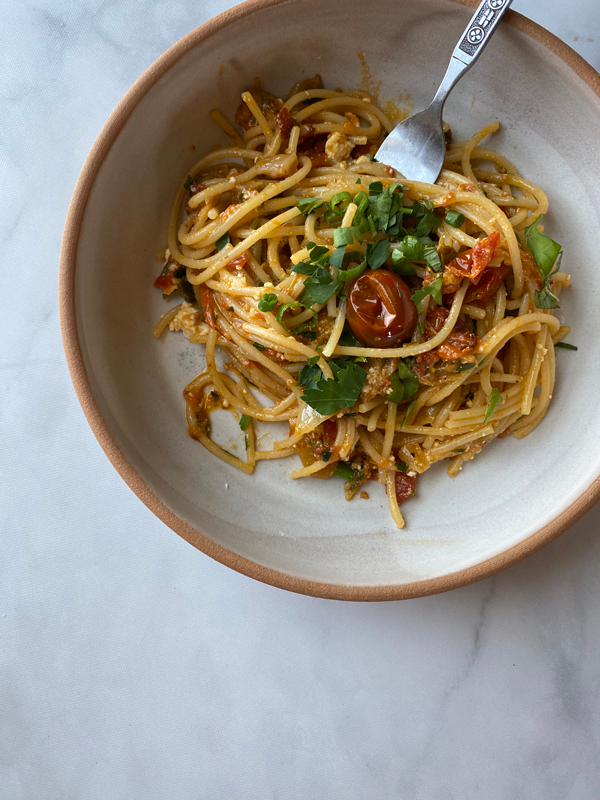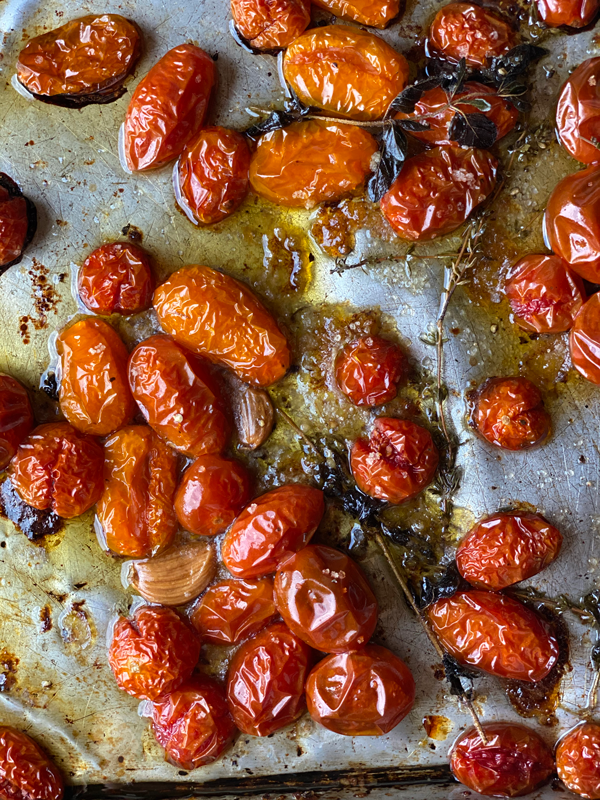I’m not sure if there is a vegetable more anticipated, more revered, and more loved in a southerner’s garden than the tomato. Here in Central Texas, where the cool spring air is more prone to linger and when summer’s 100-degree wrath rears its head so suddenly, the season for (field-grown) tomatoes is actually quite short. A flash in the pan, hot with olive oil, sliced garlic, and torn basil, the primordial summer medley that tugs at my heart with the same fever as a shockingly cold spring-fed swimming hole, a perfectly balanced margarita, or a love song strummed on an acoustic guitar, hummed on the porch at dusk.
For all their culinary ubiquity, tomatoes are actually quite picky. If nighttime temperatures fall below 55 degrees, or if daytime temperatures rise above about 90, tomatoes will lose their flowers, and while the greens themselves are technically edible, they’re not why we’re here.

When I was growing up, my dad would preach about the merits of a homegrown tomato. What were once empty words now feel like a summertime compass. True north is a dark crimson tomato, plucked from the vine at optimal ripeness. More than any other plant in my garden, tomatoes seem to beckon my awareness. I don’t resent their neediness, and instead happily kneel with the fragrant limbs and leaves. The smell of these fires neurons so consequential-seeming to the makeup of my own memory bank that, on a really hot day, it’s hard to tell where I end and tomatoes vines begin.
After transplanting, tomato bushes slowly build, as does my care – trellis, prune, and hold your breath that hail and hornworms stay away. Like tiny ornaments on a tree, yellow flowers unfurl, containing all the organs (pistil and stamens) necessary to create a green fruit – an origin story so inspiring that I actually just stopped mid-sentence to go and inspect my burgeoning slicing tomatoes who seem to be catching up from our particularly wet May.
Tomatoes, indigenous to Central and South America, have undergone centuries of breeding. Today, there is a lexicon of tomato varieties that color even the grocery store shelves during the summer months.
The Kerrville Farmers’ Market (Fridays, 4-7 p.m.) is celebrating the season with a Tomato Fest on July 2nd. There will be tomato cookies and tomato contests, to name a few.
Hat & Heart Farm plans to pair Hill Country wine with its tomatoes for an on-farm tasting experience this fall, a sneaky window of time when brave and enterprising farmers, undeterred by threats of an early freeze, can grow tomatoes again.
Botanically, tomatoes are a berry – which is a fruit (in case you still weren’t clear on that one) – and each season I make sure to grow an unreasonable number of plants in my home garden-for-two. Each juicy variety – from the minute Sungold to the mammoth German Pink – has a place in my kitchen. Even the green ones do it for me. Yes, they certainly deserve a dunk and fry at least once this season, but green tomatoes are more versatile than that. Make a jam, bake them in a pie, sub them for tomatillos, or roughly chop them and add them to a Southeast Asian-inspired coconut curry where they will hold up nicely to a soft simmer.
When it’s too hot to turn on the oven, go raw. With the addition of a bit of salt, a ripe tomato is a perfectly balanced bite of sweet and umami-like acidity, making any dish it graces nearly scream with summertime savor. Tomato season is reason enough to invest in a nice bottle of real balsamic vinegar (you only need a few drops!), and basil is never a bad idea.
For such a special crop, you might as well know the best way to store them: remove the stem, and keep at room temperature, stem-side down which will help protect the soft, juicy bottom. If you need to hurry up a blushing tomato, you can trap the ripening ethylene gas by placing your fruit in a brown bag (with a banana if you have it), and half-way folding the top so that most of the gas is trapped, but there is still some circulation. Minus the banana, this also makes for a lovely way to share your tomato bumper crop with the ones you care about.
And when your tomatoes really turn it on, consider your future self and “put up” some tomatoes for cold, rainy days, the reality of which seems impossible to imagine. Like your grandma, you could waterbath your tomatoes – whole, diced, or in a slowly-simmered sauce. When your garden or the farmers market provides an inspiring ratio of tomatoes to peppers, you can make a batch of salsa to can or even freeze, only a bag-of-chips away from a celebrated party snack. One year, I froze a refreshing mixture of lime juice, fresh tomato juice, salt, spices, tajin and Worcestershire into tiny michelada-bombs that got plunked into cold glasses of beer.
This year, garden-willing, I think I will do the same because goodness knows I’m ready to share a lunch-drink with my friends.
And when the cherry tomatoes, specifically, seem to drip from the vines, you can preserve them using one of my favorite methods – an easy to do and freezable tomato confit.
CONFITED CHERRY (OR OTHERWISE) TOMATOES
To make the time heating up your kitchen worthwhile, confit tomatoes when you have enough to nearly fill a pan or tray. For a true confit (meaning cooked in oil), your tomatoes should be completely submerged in olive oil, but I’m here to tell you that any version of tomato and oil submersion will yield a delicious end-product that you’ll be happy to retrieve from the freezer.
As you’ll see, this is more of a method than a precise recipe, meant to bend to whatever tomatoes crowd your countertops. The use-cases for these frozen, semi-dehydrated, and oily tomatoes are endless. If you need some guidance, feel free to reach out on Instagram – @clubhomemade.
Ingredients:
1-2 cups olive oil
2-10 lbs. fresh tomatoes; cherries tomatoes kept whole, plum tomatoes sliced in half long-ways, and large slicers quartered
3-10 cloves of garlic, peeled
Any combination of fresh or dried herbs you’d like including: thyme, oregano, basil, or bay leaf
Salt
Freshly cracked black pepper
Several small freezer-safe containers like ziploc bags, tupperware, or silicone molds
Directions:
Place a rack in the center of your oven, and preheat to 215 degrees F.
Gather your tomatoes, and put them on a large foil-lined baking sheet or roasting pan, like a Pyrex. Pour 1-2 cups of olive oil over the tomatoes. The amount you use will depend on how generous you’re feeling, the amount of tomatoes you’re using, and the size of your pan. Luckily, there isn’t a right or wrong answer.
Sprinkle salt and pepper over the tomatoes, and scatter your herbs. With clean hands or a spoon, toss the tomatoes, making sure oil and salt coats each tomato. If using sliced tomatoes, arrange them so a cut side is down.
Bake for 2 to 3.5 hours, or until the tomatoes are pleasantly shriveled, but still maintaining some shape. If your tomatoes are cut, flip them over for the last 30 minutes of cooking. Once cooked, let tomatoes and oil cool to room temperature, and discard herbs. Divide tomatoes and garlic into several freezable containers. I find that having about ½ a cup of tomatoes is a good amount to defrost at a time. Pour remaining oil over tomatoes into your containers of choice. Refrigerate and use within 2 weeks, or freeze for up to 3 months.
How to use?
~ Top a block of goat cheese or feta with warmed tomato confit. Serve with crackers or bread.
~ Make a tomato galette, and delight everyone around.
~ Use as the base for a dressing to coat a pasta or a grain salad, not being afraid to also add raw tomatoes to the mix, too.
~ Defrost, and scoop out the tomatoes and some oil and add to a quiche or scatter around a roasted chicken. Use the oil to make a vinaigrette and serve over more tomatoes with freshly grated parmesan and plenty of fresh herbs.




